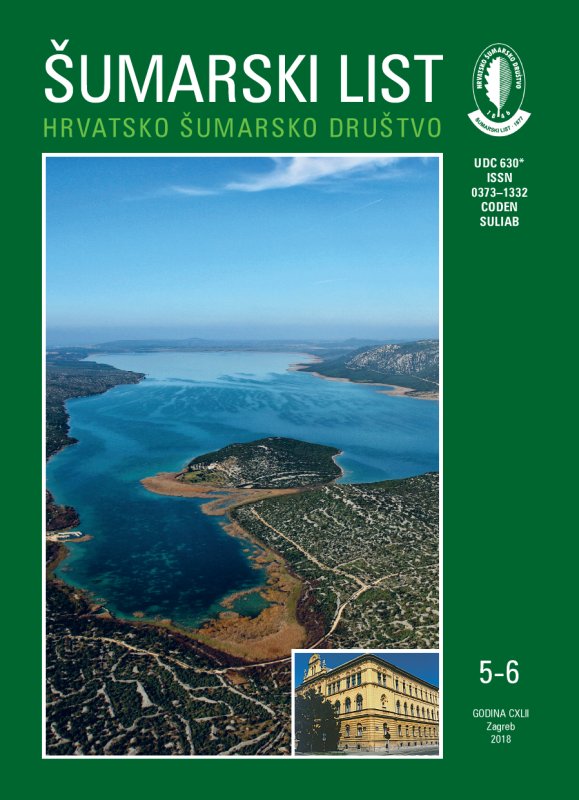
broj: 5-6/2018
pdf (21,91 MB) |
|
||||||||||||||
| RIJEČ UREDNIŠTVA | ||
| Uredništvo | ||
| HOW TO PROCEED IN THE FUTURE? pdf HR EN | 233 | |
| IZVORNI ZNANSTVENI ČLANCI | ||
| Damir UGARKOVIĆ, Ivica TIKVIĆ, Krešimir POPIĆ , Josip MALNAR , Igor STANKIĆ | UDK 630* 231 + 111.8 (001) https://doi.org/10.31298/sl.142.5-6.7 | |
| MICROCLIMATE AND NATURAL REGENERATION OF FOREST GAPS AS A CONSEQUENCE OF SILVER FIR (Abies alba Mill.) DIEBACK pdf HR EN | 235 | |
| Krunoslav SEVER, Saša BOGDAN, Jozo FRANJIĆ, Željko ŠKVORC | UDK 630* 160 (001) https://doi.org/10.31298/sl.142.5-6.6 | |
| NONDESTRUCTIVE ESTIMATION OF PHOTOSYNTHETIC PIGMENT CONCENTRATIONS IN PEDUNCULATE OAK (Quercus robur L.) LEAVES pdf HR EN | 247 | |
| Summary The concentration of photosynthetic pigments (chlorophylls and carotenoids) in leaves of forest trees is a good indicator of the photosynthetic efficiency, level of nutrition with nitrogen and autumn leaf senescence. Thus the photosynthetic pigment concentrations is one of the most significant parameters related to the physiological status of plant. Change in pigment concentrations of leaves indicate presence of environmental stress. Well-timed detection of environmental stress play a crucial role in preventing damage on seedlings and saplings in forest nurseries and wood mass production in forest cultures and plantations. Traditional methods for determining the concentrations of photosynthetic pigments represent an obstacle to continuous monitoring concentrations of photosynthetic pigment in leaves of forest trees, primarily because they are relatively expensive, long lasting and require destruction of plant material. However, portable optical chlorophyll meters such as CCM-200 (Opti-Sciences, Tyngsboro, Massachusetts, USA) and SPAD-502 (Minolta Camera Co., Osaka, Japan) is a reliable alternative to traditional laboratory methods. To use chlorophyll meters as a tool for estimating photosynthetic pigment concentrations in leaves, it is necessary to construct regression equations (calibration equations) that reliably describe the relationships between the relative index of the total chlorophyll content in leaves (CCI) and the total pigment concentrations in leaves, determined by standard laboratory methods. In the present study, we set up experiment to establish the ability of the hand-held CCM-200 chlorophyll meter to accurately estimate the content of the photosynthetic pigments in leaves of Quercus robur L. with contrast level of soil moisture. The objectives of the present work were: (i) determine whether the long-lasting drought period significantly influences the relationship between the CCI obtined by CCM-200 and the concentration of photosynthetic pigments (total chlorophyll and carotenoid); (ii) construct calibration equations for non-destructive estimation of photosynthetic pigments in Q. robur leaves; (iii) to analyse the improvement estimation of photosynthetic pigments concentration when CCI was corrected with specific leaf mass. The research was carried out during the year 2015 on 60 two-years old plants grown in the greenhouse located in the Croatian Forestry Institute Jastrebarsko. Plant material was grown in 50 liter containers previously filled with soil originating from a natural oak stand. In the spring of the 2015, at the beginning of the study the mean height of investigated plants was 23.9 ± 4.8 cm. During the study, plant material was exposure to different level of soil moisture. In control treatment soil water content was kept above field capacity, while in drought treatment plants were exposed to water reduction during 112 days (1st of April – 21st of July). In second part of growing season (22nd of July – 22nd of October) in both treatments soil water content was kept above field capacity (Figure 1). Calibration equations, that describe relationship between relative chlorophyll content index measured with chlorophyll meter and actual photosynthetic pigment concentrations in sampled leaves (laboratory determined) at the end of growing season (27th of October), were constructed for both treatments (Table 2 and 3; Figure 4 and 5). Obtined results show that parameters of calibration equations were not affected by drought treatment (Table 4). Therefore, when using appropriate calibration equations, clorophyll meter CCM-200 can be considered as reliable tool for non-destructive estimation of total chlorophylls and carotenoids in Q. robur leaves, regardless of different soil water regimes during the growing season. Additionaly, this research confirmed that it is possible to improve the estimation of actual photosynthetic pigment concentration by using chlorophyll content index corrected with specific leaf mass (Table 2 and 3; Figure 4 and 5). Key words: chlorophyllmeter CCM-200; relative leaf chlorophyll content index; specific leaf mass; total chlorophylls; carotenoids | ||
| Martina TEMUNOVIĆ, Jozo FRANJIĆ, Federico VESSELLA, Marco C. SIMEONE | UDK 630* 165 + 17 (001) https://doi.org/10.31298/sl.142.5-6.5 | |
| RESOLVING THE TAXONOMIC STATUS OF THE MYSTERIOUS „GREEN OAK“ (Quercus× viridis Trinajstić) FROM CROATIA BASED ON PHYLOGENETIC ANALYSIS pdf HR EN | 259 | |
| Murat ALAN, Rumi SABUNCU, Turgay EZEN, Selim KAPLAN | UDK 630* 232.3 + 233 (001) https://doi.org/10.31298/sl.142.5-6.1 | |
| THE EFFECTS OF TOP PRUNING ON GROWTH AND PRODUCTION OF CONELETS AND CONES IN Pinus brutia Ten SEED ORCHARDS OF DIFFERENT AGES pdf HR EN | 269 | |
| PRETHODNO PRIOPĆENJE | ||
| Mirza DAUTBAŠIĆ, Osman Mujezinović, Kenan ZAHIROVIĆ, Josip MARGALETIĆ | UDK 630* 453 https://doi.org/10.31298/sl.142.5-6.4 | |
| FIRST RECORD OF ELM SAWFLY (Aproceros leucopoda) IN BOSNIA AND HERZEGOVINA pdf HR EN | 283 | |
| PREGLEDNI ČLANCI | ||
| Nedim TUNO, Admir MULAHUSIĆ, Jusuf TOPOLJAK | UDK 630* 582 https://doi.org/10.31298/sl.142.5-6.3 | |
| COMPARATIVE ANALYSIS OF DIFFERENT APPROACHES TO THE CORRECTION OF GEOMETRIC DISTORTION IN THE OLD FORESTRY MAP pdf HR EN | 287 | |
| STRUČNI ČLANCI | ||
| Damir DRVODELIĆ | UDK 630* 181.5 https://doi.org/10.31298/sl.142.5-6.2 | |
| PROPAGATION OF PAULOWNIA BY ROOT CUTTINGS pdf HR EN | 297 | |


